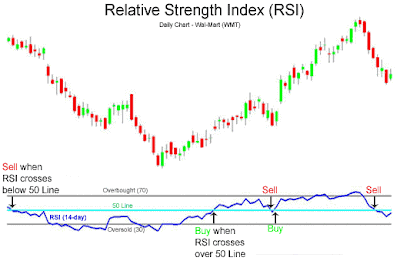- Buy when price and the Relative Strength Index are both rising and the RSI crosses above the 50 Line.
- Sell when the price and the RSI are both falling and the RSI crosses below the 50 Line.
Relative Strength Index Confirmations & Divergences
A powerful method for using the Relative Strength Index is to confirm price moves and forewarn of potential price reversals through RSI Divergences.The chart below of the E-mini Nasdaq 100 Futures contract shows the RSI confirming price action and warning of future price reversals:
Low #1 to Low #2
The E-mini Nasdaq 100 Futures contract's price made a substantial move from Low #1 to Low #2. The RSI confirmed this move, helping a trader have confidence jumping on board the price move higher.The break of trendline of the e-mini future was also confirmed by the trendline break of the Relative Strength Index, confirming that the price move was likely over.
Low #3 to Low #4
A bullish divergence was registered between Low #3 and Low #4. The e-mini Nasdaq 100 future made lower lows, but the RSI failed to confirm this price move, only making equal lows. An astute trader would see this RSI divergence and begin taking profits from their shortsells.High #1 to High #2
A bearish divergence occured when the e-mini futures contract made a higher high and the RSI made a lower high. This bearish divergence warned that prices could be reversing trend shortly. A trader should consider reducing their long position, or even completely selling out of their long position.The Relative Strength Index is a popular tool for generating buy and sell signals, confirming trends, and warning of impending price reversals.

